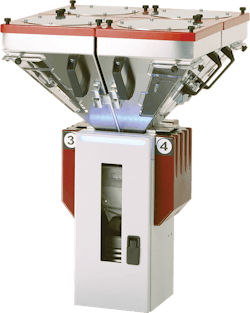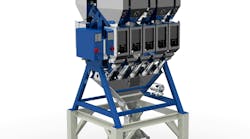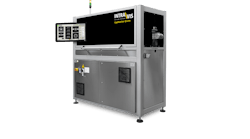“This is something manufacturers have been after for some time, trying to figure out how to have their machinery and equipment run efficiently without needing operators standing there, and Wittmann Battenfeld can do this now,” said Rick Hagfors, national sales manager.
For example, the company’s Aton Basic H and Plus H segmented wheel dryers feature a seven- day timer that users can program to start and/or stop automatically at a specific time for each day of the week.
“That’s part of lights-out — not having to send somebody in at 4 a.m. to turn your dryers on, so things are ready when the shop goes up between 7 a.m. and 8 a.m.,” Hagfors said.
The company introduced the Aton H series dryers at NPE2018 last May. While timers were available on the previous G series, the H series also is compatible with Wittmann 4.0, software that links devices to an injection molding work cell. The software allows the primary machine to monitor the dryers and is an alternative means for turning the dryers on and off.
Wittmann Battenfeld’s Gravimax G14, Gravimax G34 and Gravimax G56 blenders also can be connected to an injection molding cell with Wittmann 4.0. Among the software’s advantages is its ability to automatically shut down a line or send an alarm if a blender runs out of material. That can prevent the production of bad parts and conserve electricity associated with powering equipment that is not in use, Hagfors said.
The G14 can blend four materials and has a throughput of 170 pounds per hour; the G34 can blend four materials and has a throughput of 450 pounds per hour, and the G56 can blend six materials and has a throughput of 1,320 pounds per hour.
Inter-equipment communications create efficiencies among Wittmann Battenfeld’s auxiliaries.
For instance, the company’s MC Balance, a gravimetric color and additive feeder for injection molding and extrusion, can be connected to an injection molding machine (IMM). When the machine needs material, it can signal the feeder through a wired connection.
Wittmann Battenfeld’s M7.3 network control coordinates the vacuum pumps and loaders of a material conveying system, as well as central dryers.
For example, the M7.3 would know when to turn on another vacuum pump to allow the conveying system to keep up with demand. The M7.3 can control as many as eight pumps. It also can coordinate the operation of central dryers.
S-Max and G-Max beside-the-press granulators have an option allowing communication with the IMM or a robot. The company introduced the option this year.
When it shuts off, whether because it has finished a job or experienced an error condition, the IMM or robot can tell the granulator to shut down, saving energy, Hagfors said.
“If the job is complete or there was an error causing the work cell to shut down, you can tell the granulator to turn off until someone comes in,” he said.
The S-Max and G-Max granulators are designed for closed-loop recycling of sprues and runners. The G-Max is a traditional screen-type granulator, and the S-Max is a screenless granulator for tougher materials, such as PC or polyamide with glass, mineral or other fillers. The S-Max was introduced at NPE2018.
In addition to a hardware connection between the IMM or robot and the granulator, sensors also can be used to automatically shut down the S-Max and G-Max. For example, a sensor could monitor sprues as they drop into the granulator bin. If a sensor doesn’t detect any sprues after a certain number of minutes, the granulator can be shut off automatically.
The company’s Tempro Plus D and Tempro Plus D Direct model temperature- control units (TCUs) can be connected either to Wittmann 4.0 or to an IMM interface for lights-out operation. Like much of the latest equipment from the company, the feature was introduced at NPE2018.
“Similar to the granulator, where if the work cell is shutting down due to a problem, the molding machine could signal the TCU to shut down. Conversely, if something goes wrong with the TCU, it could signal the IMM to disrupt its cycle,” he said.
For example, if a molding machine runs out of material, it could communicate to the TCU that it is turning off and the TCU should power off to save energy. On the other hand, if a hose breaks on the TCU, it can communicate to the IMM to shut down.
Bruce Geiselman, senior staff reporter
Contact:
Wittmann Battenfeld Inc. Torrington, Conn., 860-496-9603,







